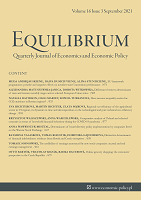Determinants of youth unemployment rate: case of Slovakia
Determinants of youth unemployment rate: case of Slovakia
Author(s): Mário Papík, Paulína Mihaľová, Lenka PapíkováSubject(s): Labor relations, Socio-Economic Research, Sociology of Education
Published by: Instytut Badań Gospodarczych
Keywords: youth unemployment; unemployment rate for graduated students; work motivation; determinants of unemployment; quality of high schools;
Summary/Abstract: Research background: The employment rate of young individuals in the labour market has considerably decreased in developed countries recently. Due to lower labour capital, skills, and generic and job-specific work experience, youth consider finding suitable job challenging. If they fail to succeed in the labour market soon after graduation, it leads to long-term unemployment, unstable and low-quality jobs, and even social exclusion. Purpose of the article: This paper aims to analyse the unemployment rate of high school-graduated students and the factors impacting this unemployment rate, such as GDP per capita, total unemployment rate, apartment price per square meter and results from state exams. Identifying the determinants affecting youth unemployment is crucial for theoretical knowledge and for policymakers to ensure youth inclusion in the economic mainstream. As a result, society can reduce social and economic costs and avoid structural problems in the future. Methods: Data about 464 Slovak high schools from National Institute for Certified Educational. Data include the graduate unemployment rate for each high school in Slovakia. Furthermore, two logistic regression models have been developed to investigate the impact of selected factors on high school graduates? unemployment rate immediately after graduation and nine months after graduation. Findings & value added: This paper indicates the existence of statistical dependency between unemployment of high school graduates and overall unemployment rate in the region, GDP per capita in the region, quality of high school education and cost of living in the region immediately after graduation. Analysis of the period nine months after graduation has shown the important decline of education quality provided by high schools. To reduce youth unemployment, the state should focus primarily on improving overall unemployment itself by implementing a dual-learning system, simplifying business opportunities, making part-time work available, or introducing lifelong learning to help transform the economy into a knowledge base.
Journal: Equilibrium. Quarterly Journal of Economics and Economic Policy
- Issue Year: 17/2022
- Issue No: 2
- Page Range: 391-414
- Page Count: 24
- Language: English

